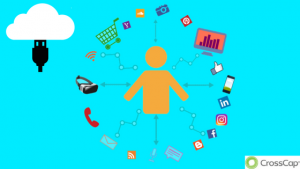(Updated on 12.21.22)
“Omni-channel marketing” phrase has been making a lot of noise in the recent years. Previously considered a fancy industry slang and used by many companies to differentiate themselves from the competition, today’s “Omni-Channel” is no longer a competitive advantage but a Must – Do approach to business and its operations.
Multi-channel vs omni-channel
Being “Multi-channel” meant to achieve the reach and discoverability by hitting the audience with a marketing message across the different marketing channels.
Today, it’s no longer enough to have as many touch points with potential consumers as possible to make a transaction. The quality of the experience matters to consumers. That’s where omni-channel marketing comes into play.
Omni-channel is a two-way conversation between a company and a user where the user is having a seamless experience with the brand at all points of his journey.
We need to be where our audience is, speak their language, deliver messages in the format of their preference, address their problems and concerns as well as anticipate the questions.
Two factors that help establish omni-channel marketing approach:
- People – are all the stakeholders aligned?
- Tools – if you are a global organization with multiple stakeholders involved, the proper tools can be the key for your company to turn your siloed efforts into one cohesive customer-centric strategy.
What is it like for an organization to be omni-channel?
You need to audit your internal organizational processes. Here are the questions that can help:
- Are you operating in unison internally between the multiple teams?
- Are the internal marketing efforts aligned with the company’s business objectives?
- Do you have a unified archive of all customer data?
- How full or fragmented is your customer database?
- Do you personalize your marketing campaigns?
- Have you established a consistent brand experience across all channels?
Learn more about developing an omni-channel marketing plan.
How is omni-channel seen by different industries?
We reached out to the experts in the retail, pharmaceutical, and eCommerce industries and asked them one question: what does omni-channel mean in your industry? Here is what they shared:
Retail / eCommerce
Most retailers set a goal of pure omni-channel… where the customer has a 360-degree view of the retailer’s inventory, but most fail due to the following reasons.
Infrastructure: Store / logistics infrastructure is not set-up properly to support consolidated / virtual inventory with a cross-channel view
Cost: Changing systems to support omni is very expensive and in many cases, most retailers cannot afford to go through the transformation process or take shortcuts that derail the process
Vision: Omni efforts are led and innovated from the logistics division up. Logistics drives this change. If it is not led by executives that embrace and believe in the initiative, it will fail.
– Bill Thayer, Co-founder, COO / GSD, Arteria
Pharmaceutical
Omni-channel to pharma means more than connecting with patients, providers & payers on different media platforms & venues – it also encompasses sourcing data from extended sources (trends, insights, prescriptions filled, drug adherence & compliance by patients, Facebook & other social media posts regarding how patients feel & behave, etc.). Essentially, omni-channel is no longer 1-way, it must be 2-way and go in an endless loop so that data in informs messaging going out.
– Loralyn Mears, PhD, a marketing consultant with over 20 years of experience in the pharmaceutical and life sciences industries.
General
Omni-channel marketing to me as a content marketer really means to reach my target audiences on all relevant channels. The challenge here, of course, is to give them what they want and where they want it. With a strategic content marketing and authentic storytelling framework and while creating once, publishing everywhere it’s possible. Some experts claim it’s about being more focused and cutting down channels. In my experience, it’s about maximizing all relevant channels.
– Christoph Trappe, Organizational Storytelling Coach, Autor, Speaker, VP of Content Markting Strategy, Scribble Live, Founder, Authentic Storytelling.
eCommerce
An omni-channel brand presence in B2C ecommerce is not only a requirement today, companies in the industry may also be the ones with the most to gain (or lose) given the sheer size of the market. And at the same time, ecommerce, and retail in general, may be the most difficult and complex landscape in which a brand must effectively develop an omni-channel strategy without breaking the bank. Opportunities for consumer touchpoints are virtually limitless, from in-store to online, from social media to online search results, from paid online and offline advertising to consumer press and beyond. And multiple touchpoints per potential customer are usually needed in order to convert which means, especially given the degree of competition in the world today, that strong and seamless messaging is key.
So how do you maintain a seamless, omni-channel messaging strategy?
If an ecommerce property is the center of the universe, so to speak, retargeting is king. The use of internet cookies and other similar technologies to accurately track consumers as they move from device to device and from property to property can allow consistent and targeted messaging everywhere from brand’s social pages to affiliate sites to in-app advertising to in-store digital installations. Add to those retargeting efforts a solid database management and CRM strategy, plus get the entire organization on board, and there’s no reason your direct mail, post-purchase engagement and new lead touchpoints can’t present a unified message to any customer whether they’re new or already loyal to your brand. Even small ecommerce brands today may have half a dozen social media presences, pre-purchase marketing campaigns, post-purchase engagement plans, press, partnerships and more, making an omni-channel approach to the entire landscape that much more important.
– Abe Shaw, Owner, Eating Tools


